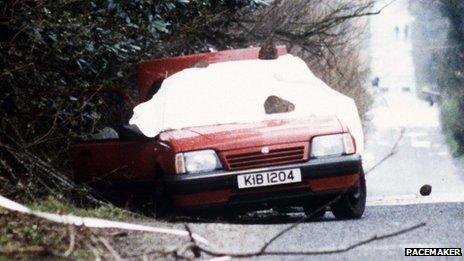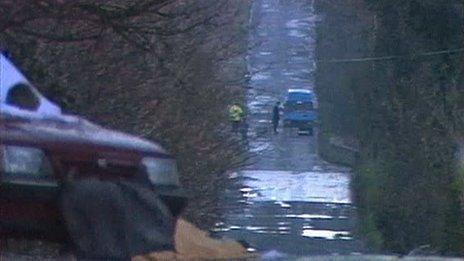Smithwick Tribunal key points
- Published

The two officers were murdered on their way home from Dundalk Garda station
The Smithwick Tribunal has concluded that Irish police officers colluded in the IRA murders of two senior Northern Ireland policemen
Chief Supt Harry Breen and Supt Bob Buchanan were shot dead in an ambush in March 1989 as they crossed the border into Northern Ireland after a meeting in Dundalk Garda station.
The report was published on Tuesday after almost eight years of painstaking investigations. It runs to 434 pages, with more than 1,000 pages of appendices.
Here are some of its key findings.
Harry Breen was probably the IRA's specific target

Harry Breen was pictured with weapons carried by IRA men at Loughgall
Mr Justice Smithwick said there was much evidence that Chief Supt Harry Breen was "the specific target of his operation".
Chief Supt Breen had been a hate figure for the IRA since undercover British army soldiers shot dead eight of its members and a civilian at Loughgall police station in County Armagh, in 1987, when he was pictured afterwards with weapons recovered by police.
His colleague Bob Buchanan had visited Dundalk about 20 times in the seven months before his death, and the judge said it was "plausible" that the ambush could have been mounted with knowledge of his regular travel combined with surveillance.
However, he said that would have been an "extraordinary piece of good fortune", and it was "significantly more likely" that the IRA knew Chief Supt Breen was coming.
Irish police leaked information to the IRA
Mr Justice Smithwick said there were two phases to the IRA operation:
IRA members were on standby ahead of the arrival of the two officers at Dundalk Garda station
Upon confirmation that they had arrived, they "moved into full operational mode"
With the first phase, the judge said the circumstances pointed towards information having been leaked to trigger the beginning of the IRA operation.
He said he found no evidence this information had come from the RUC, and it was "more likely" to have come from Dundalk Garda station.
He said this was supported by information received by both the PSNI and An Garda Síochána from reliable sources "indicating that there was collusion".
With phase two of the IRA operation, Mr Justice Smithwick said it "seems beyond doubt that the IRA acquired information that the two officers arrived at the station".
Unclear who leaked the information
While the report concludes that the IRA's information about their arrival came from within Dundalk Garda station, the tribunal does not identify what individual or individuals were responsible.
The judge said he had received "live and of the moment" PSNI intelligence that the IRA had received information about the two officers from a Garda detective "who was not publicly associated to the Smithwick Tribunal".
The names of three Garda officers featured heavily in the Smithwick Tribunal's hearings, who all denied any role in the operation - Finbarr Hickey, Leo Colton and Owen Corrigan:
Finbarr Hickey: the tribunal concluded he was not on duty on the day and was not in a position to pass information to the IRA
Leo Colton: while in 1995 and 1996 he had got a colleague to sign false passport applications for the IRA, the judge said the evidence did not establish that he had colluded in the murders of the two officers
Owen Corrigan: the judge said there was some evidence that he had previously passed information to the IRA, the evidence was "not of sufficient substance and weight" to establish any collusion in the murders.
Collusion took place but there is 'no smoking gun'
The Smithwick Tribunal interpreted collusion in its widest sense, covering not just direct actions but deliberate omissions, failures to act and turning a blind eye.
In his final report, the judge said the tribunal had not uncovered direct evidence of collusion.
"There is no record of a phone call, no traceable payment, no smoking gun - this is not surprising," he wrote.
However, he said he had built up a picture of how and when the ambush was mounted and executed through a detailed examination of the day's events.
Three prior attempts to kill the officers

It emerged that there were three aborted attempts to carry out the gun attack, according to written evidence submitted by the IRA to the tribunal.
"Twice the car didn't show, on the third occasion it was tracked using the Edenappa Road on the return journey," the IRA's evidence said.
"However, due to unconnected high levels of enemy activity in the general area (an Army helicopter) we were unable to execute the operation."
The statement by former IRA personnel set out their account of how the day's events unfolded. The judge said that while it was not a "signed witness statement of any individual" and had not been tested in cross-examination, it remained a valuable resource.
Three IRA members also held a face-to-face meeting with the tribunal's legal team in April 2011.
One of them said that 90% of the IRA's operations were based "on the human weakness of habit".
On the day of the murders, three or four people were used for the surveillance, while a total of "30 or 40" IRA people "were on the ground for the operation as a whole".
Other witnesses put this figure as much higher, such as retired Army brigadier Ian Liles, who said it would have involved up to 70 personnel, including people acting as lookouts and checking roads for security patrols.
British army withdrew operation hours before shootings

The tribunal heard evidence that area around Edenappa Road, where the two officers were shot, had been "out of bounds" for a week before and was only withdrawn at 11am on the day of the shooting.
The judge said this was "noteworthy, and indeed tragic".
He said it appeared there had been a British army operation to monitor and protect the main Belfast to Dublin railway line that passed nearby.
Previous investigations were inadequate
.jpg)
Many allegations were made about the murder over the course of the tribunal
The judge said two earlier investigations examining the question of Garda collusion were inadequate.
"The best opportunity of establishing the truth of the matter arose in the days and weeks following the ambush," he wrote.
"In these circumstances, it is particularly regrettable that both police services acted swiftly to dismiss speculation of the possibility of collusion rather than to deal with that by means of a thorough and credible investigation."
He said it was an example of "the prioritisation of political expediency in the short term".
The RUC chief constable at the time, Sir John Hermon, had told journalists he had spoken to the Garda commissioner and they could categorically rule out the possibility of a mole within Dundalk station.
Relations between the RUC and An Garda Síochána were strained
The tribunal heard from a number of witnesses who questioned the true nature of the relationship between the two police forces.
Among them was former RUC officer Alan Mains, who had been Harry Breen's staff officer and knew both of the murdered men well.
He said that on the morning of the killing, Ch Supt Breen had told him he felt uneasy about going to Dundalk and expressed concern that some members of the gardaí were on the IRA's payroll.
However, he said that when he met Sir John Hermon the next day, the chief constable did not believe him.
"The chief constable was very dismissive of me making that remark and said that that was rubbish, or he disagreed, and he quickly said that that man had been investigated and he had been cleared," he told the tribunal.
The judge said evidence suggested there were attempts by superior officers to "sanitise" Mr Mains' account of events.
"I am of the view that Mr Mains was encouraged not to refer to Mr Breen's uneasiness and specific concerns about Mr Corrigan in the interest of a greater expediency, namely not to do anything which could destabilise the relationship between the RUC and An Garda Síochána," the judge wrote.
Failure to address allegations of wrongdoing
The judge said he hoped the Dublin-based tribunal had "contributed one small part" to changing a culture of failing to adequately address suggestions of wrongdoing.
"Either for reasons of political expediency or by virtue of misguided loyalty," he said, this had been "a feature of life in this state".
He said taking such allegations seriously was essential to the integrity of An Garda Síochána.